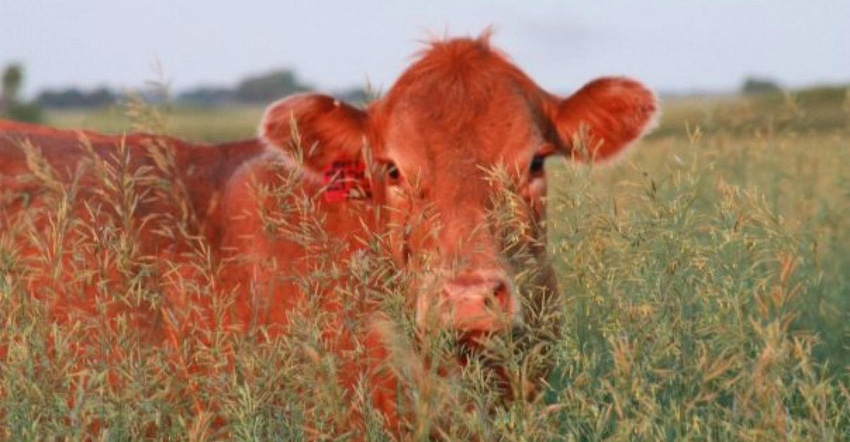The beautiful relationship between cattle & wildlife
Ranchers must drive conversations about cattle and wildlife to highlight how beef production is critical for maintaining healthy landscapes.
May 31, 2019

After a long spring plagued by cool days, heavy rains and cloudy skies, our cow-calf pairs are finally out to pasture for the summer grazing season. The sun is shining, and even though things haven’t been exactly rosy in the agricultural sector these days, it’s hard not to feel optimistic when your cows are fat and happy out on grass.
I’m not waxing poetic when I say this, but I truly believe one of the most beautiful scenes God paints is a landscape complete with rolling grasslands and cattle grazing peacefully on each hilltop and valley.
There’s no better way to end a summer day than to watch the sunset on our bovines as they happily munch on a mix of native grasses. Bees buzz from flower to flower. Birds take a rest on top of the cows’ backs. Beatles and earthworms dig into the rich, dark soil. Rabbits and mice dart quickly from place to place while foxes and coyotes fix their steely eyes on their prey in the distance.
Environmentalists may argue that this scene would be even more beautiful without ruminant animals on the landscape. What do we need cattle and sheep for, if we have naturally roaming antelope, pronghorns or buffalo on our nation’s lands?
However, without cattle — and the responsible land owners or tenants who manage the land they graze on — much of these rangelands would become barren wastelands or would cease to exist as wildlife habitat altogether.
So often, ranchers and environmentalists are at odds with each other — each having a set of conservationist viewpoints that don’t necessarily match up.
Yet, it’s exciting to see new collaborations taking place between wildlife and conservation groups and the ranching communities who lease federal lands or own private lands.
Because the truth of the matter is this — ruminant animals and wildlife can co-exist and thrive together in the same environment. And it’s because of responsible management practices (not a hands-off approach that so many push for) that allows for multi-purpose use of the land that benefits industries such as timber and agriculture, as well as wildlife, hikers, tourists, hunters, photographers and other recreational uses of the land.
Cattle achieve this by maintaining the grasslands, instead of these acres being converted to fields for crops or concrete for urbanization. Cattle also reduce the fuel for wildfires through grazing and promoting biodiversity of the soil with their manure and by aerating the land with their hooves.
They truly work in beautiful concert with the landscape, and I think it’s something we as an agricultural community should do more to highlight. This is a particularly fitting message this summer as many Americans will travel to cattle country, where they will see wildlife and cattle co-existing on these federally protected lands.
I was pleased to see a recent article in the Mountain Journal that addressed this topic. Written by Lesli Allison, executive director of the Western Landowners Alliance, the article is titled, “Ranchers play key role in saving Greater Yellowstone’s wildlife pathways.”
Allison writes, “If you want to find abundant wildlife, look on a well-managed ranch. If you want to conserve wildlife and wildlife corridors, conserve the ranch.
“This doesn’t just mean putting conservation easements in place. It means keeping working land ranching operations economically viable, so that the land can be well managed, so the kids can come back home, so that rural communities can thrive and in turn sustain the working lands.
"Just as working lands sustain wildlife, so should wildlife be helpful in sustaining working lands. Wildlife are an important economic driver in western states, yet in many places, the working lands that sustain the wildlife see the least economic benefit and often experience the greatest impacts,” she says.
“Forage competition, fence damages, disease transmission, depredation, hunting pressure and more can impact the bottom line in a business where profit margins are already low and getting worse. This lopsided relationship is unsustainable and damaging to all interests.
“The agricultural community has much to gain by taking pride in our stewardship and pro-actively identifying and championing win-win strategies rather than seeming to oppose wildlife at every turn. It’s not enough to say we are the original conservationists. We need to demonstrate active leadership in sustaining the entire living community of the land within our care."
Read the entire article by clicking here. Let’s own this conversation and start highlighting the beautiful relationship between ruminant animals and wildlife.
The opinions of Amanda Radke are not necessarily those of beefmagazine.com or Farm Progress.
About the Author(s)
You May Also Like





